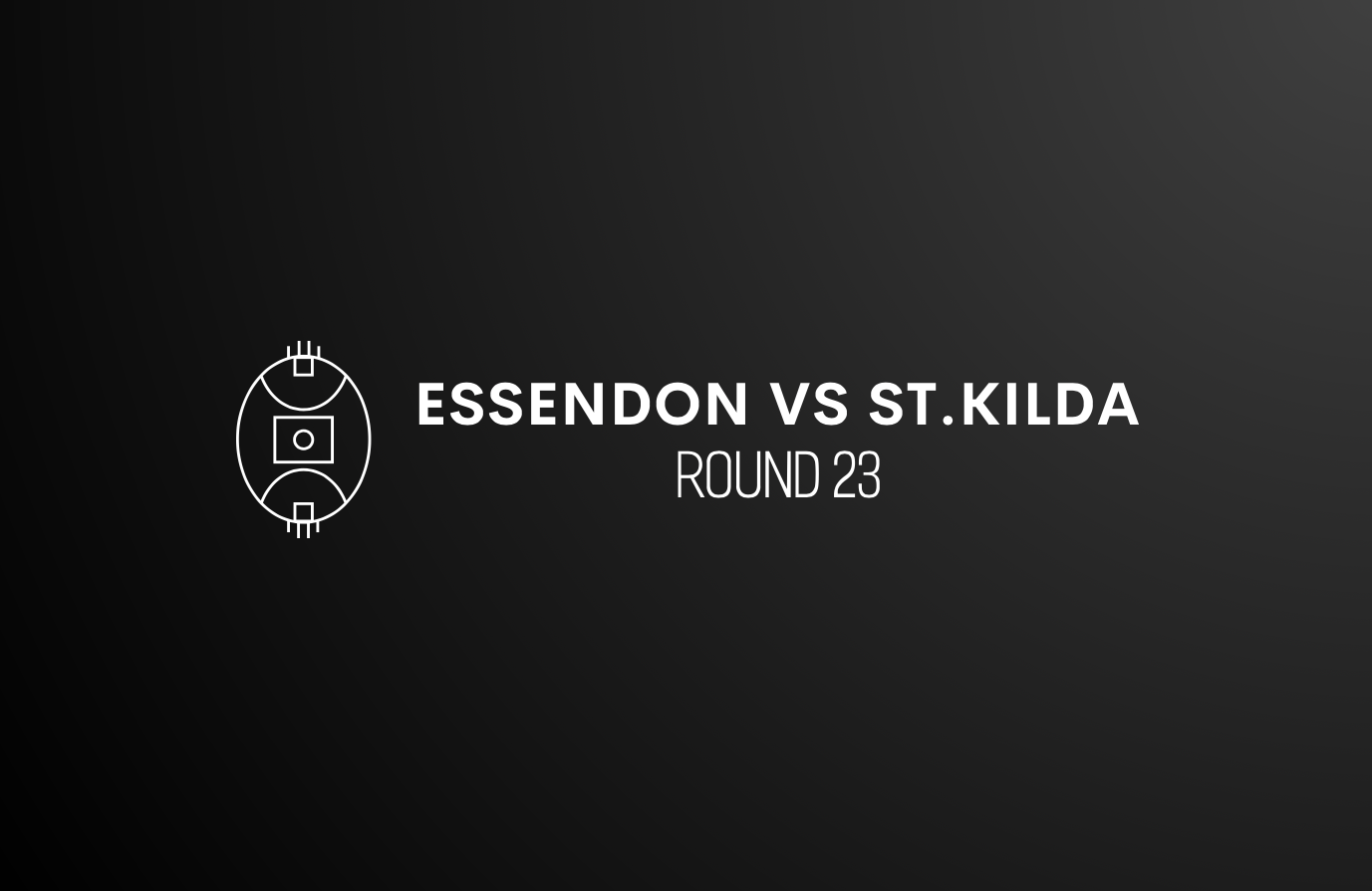
Bombers vs Saints Review
- thebombersblog

- Aug 17
- 7 min read
Missed by that much.
For far longer than at any other point in the second half of the season, victory was within reach. A win here would have been a timely boost for a side that continues to grind through the hard yards each week despite the constant obstacles thrown its way.
As this challenging stretch has worn on, more and more has been asked of this young group, requiring them to step up, take on greater responsibility and keep pushing. To come so close will inevitably bring some frustration, but it should also reinforce that the work being put in is edging closer to the rewards it deserves.
This versus that.
In my preview of this game, I outlined several key performance indicators I’ve been tracking this season, metrics I believe are essential for success in the modern game, and compared Essendon and this week’s opponent, St Kilda, against the rest of the competition.
Now we can revisit those same areas to see if there were any improvements or not, and assess how those would stack up if Essendon could sustain them over the course of a season.
Stoppages.
This had the biggest impact on St Kilda’s game, while also shaping Essendon’s performance, though not as significantly as it could have based on the raw numbers.
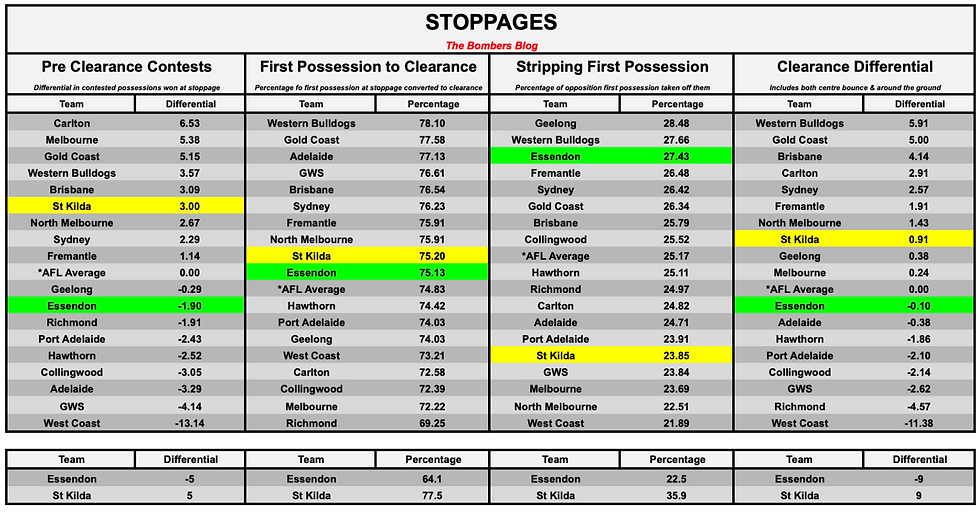
• Essendon’s second, or really third-choice, midfield rotations struggled to get their hands on the ball pre-clearance.
For Essendon, only Sam Durham (the club’s second-ranked player at winning stoppage contests, behind Jye Caldwell) and Andrew McGrath were able to consistently impact these contests, while St Kilda had a much wider range of players who could reliably stand up, including Jack Steele, Nasiah Wanganeen-Milera, Marcus Windhager, and Hugo Garcia. Jack McCrae also contributed, but well below his season average of over 10, finishing with only five this week.
• St Kilda’s ability to win contests meant they were more dominant at turning first possession into effective clearances.
Coming into the game, the Bombers were the third-best team at stripping opponents from converting that first possession, but this week they only stripped 22.5%—their sixth-lowest rate for the year.
• By game’s end it was a -9 differential in total clearances.
The biggest issue came in quarter two, where the Saints won centre clearance four-to-one, and stoppages around the ground seven-to-four. These clearance losses didn’t directly contribute on the scoreboard, but they set up field position and changed the course of the game in that time.
Clearance to shot at goal rate.
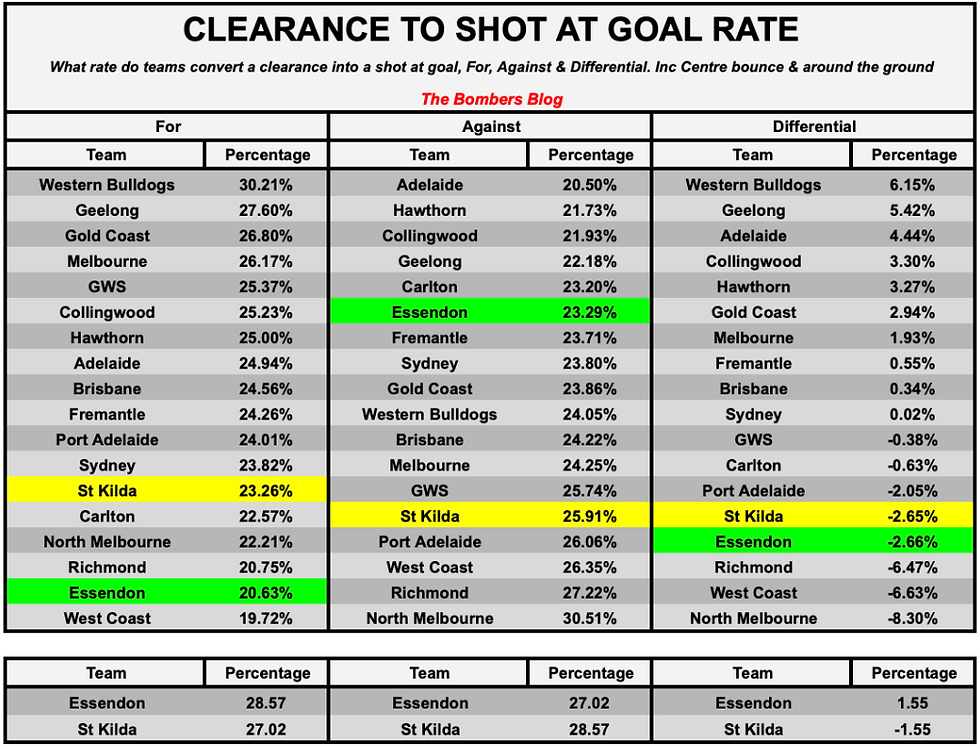
• Despite Essendon almost breaking even at stoppages this year, they’ve converted just 20.6% of their clearances into shots at goal, only ahead of West Coast. So it was encouraging to see them take advantage against a team more vulnerable in this area of the game.
• In the second quarter, where St. Kilda had control when the game stopped, they managed just two scoring shots at goal from those 11 clearances, while Essendon exceeded their season average in denying shots from this score source by another 5%.
For all the troubles and issues they’ve currently got in their game, it’s been pleasing to see this aspect stand up through the majority of the year.
• The stoppage battle was a much more even contest in the second half, with Essendon breaking even around the ground and maximising the centre square, with two shots started there, thankfully both goals.
After the break, five of the Bombers’ six goals came from stoppages, as this became the number one score source.
Possessions.
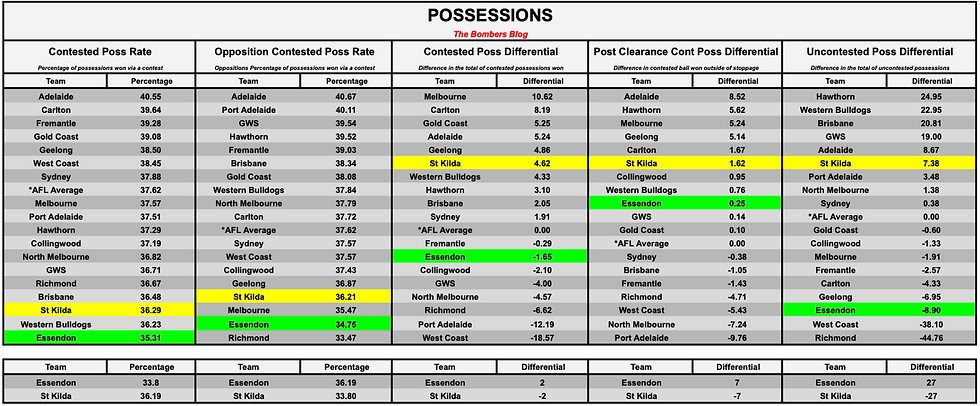
• For the past six weeks Essendon hasn’t been able to play games on its own terms, with the opposition dictating the style from the opening bounce.
During that stretch, the Bombers averaged an uncontested possession deficit of 39.3, with 13.6 of that damage coming in first quarters alone. This week, though, they finally opened with some control, finishing +6 in the first term and adding another +9 in the second.
• Contested possession numbers were almost even across the game, with St Kilda stronger pre-clearance and Essendon more effective post.
Much of the Bombers’ work came early and behind the ball, through Mason Redman (not usually a strength of his), Lachie Blackiston (currently Essendon’s second-highest ranked defender in this metric), and Jayden Laverde. For the Saints, Cooper Sharman stood out as the most dominant forward on either side, winning eight.

• Coming into the game, St Kilda ranked number one in the competition for ground ball wins, with their biggest strength being loose ball (contests outside). But Friday night, Essendon was able to limit the influence of McRae, Wanganeen-Milera, Windhager, and Jack Sinclair, finishing +9 in that area largely through the work of Sam Durham and Andrew McGrath.
• It was a different story at hard ball, where the Saints’ weight of rotations told, with the Bombers finishing -13, their second-biggest loss behind the -18 against Sydney two weeks earlier, and one of the main holes I would like to see addressed in the offseason through drafting or trading.
Ball movement.

• A low stoppage game, combined with long possession chains (3.51 possessions per chain for Essendon, 3.19 for St Kilda), meant that both teams only started with the ball 203 times in total (Essendon 101, St Kilda 102), down from the AFL average of 225.
• The Saints are the second-best team at denying defensive 50 to forward 50 transitions among non-finals contenders, so it was encouraging to see Essendon challenge their setup when possible.
They did this by finding uncontested marks (96 in the back two-thirds) and changing direction inside defensive 50 instead of playing in “straight lines” when so deep in defence.
• There was also a slight improvement in the Bombers’ ability to defend transitions compared to their season average, with most of the gains coming in the first quarter off the back of 14 front-half intercepts. Despite this, ball movement hasn’t been a strong point for St Kilda this season, yet in this game they were still able to go more than 6% above their 2025 average.
• Even though St Kilda moved the ball “end to end,” Essendon prevented it from transferring onto the scoreboard, recording their best rate of the season in denying defensive 50 rebounds that ended in a score.
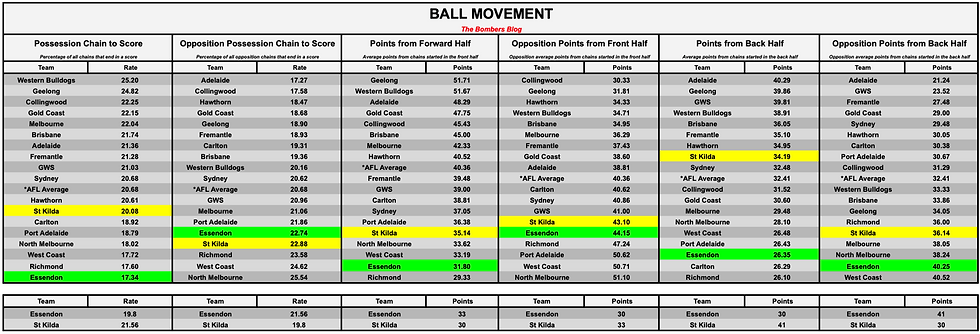
• By halftime, Essendon was able to turn a chain into a score over 23% of the time, boosted by a second quarter of just under one in every three.
The third quarter was still above their season average, and by the end of the game, 19.8% ranked as their seventh best for the year. St Kilda’s most damaging periods were the two middle quarters, going at 27.7% for their eight goals, four behinds.
• Seven of the Bombers’ 11 scoring shots up until halftime came from forward-half chains, while five of their nine second-half scoring shots came from the back half, as the intercept structure behind the ball wasn’t nearly as effective, particularly after the first 20 minutes.
Intercepting.

• This week, Essendon got back to some of their 2024 intercept form, winning the ball back every 5.06 possessions, a rate that would absolutely stand up this season.
The first quarter set the tone, intercepting every 4.28 possessions with 14 of their 21 coming in the front half. This set up 67% time in forward half and three scoring shots from intercepts in that part of the ground.
• Unfortunately, Essendon weren’t up to the same intercept standard in the two middle quarters, not helped by losing initial territory from centre bounces and then around the ground, which forced the structure behind the ball to win it back further from goal.
Between quarters two and four, Essendon only intercepted in the front half another 10 times, with 56% of the game played in St Kilda’s half.
Forward lines.
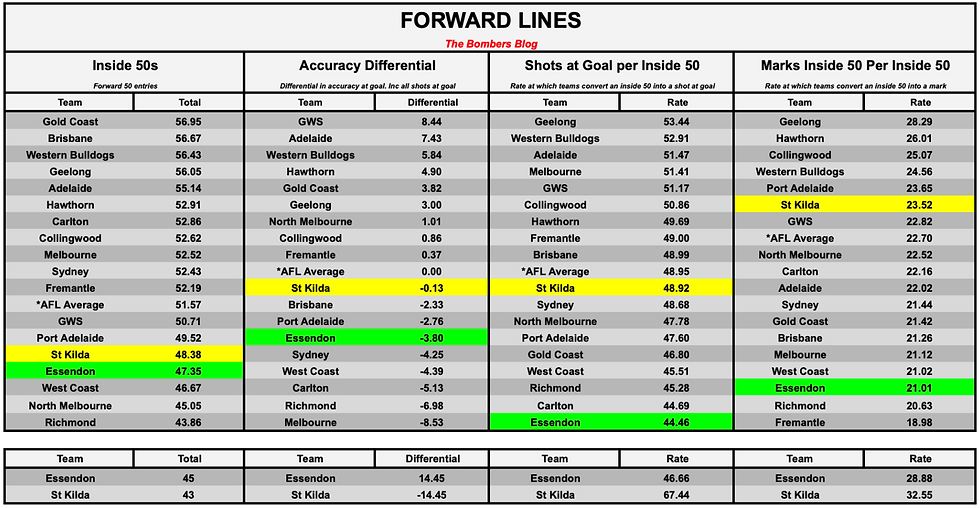
• After 18 inside 50s in the first quarter, Essendon could only manage another 27 over the remaining three quarters, but it was quality over quantity.
In the last 60 minutes, they found a marking target 37% of the time and converted an entry into a shot on goal 55.5% of the time. This was their best three-quarter rate of the season, with round two against Adelaide the next best at 53.3%.
Backlines

• While Essendon was effective inside forward 50, so were St Kilda.
With an already weakened backline entering the game, and Laverde subbed off due to injury, the Saints managed 29 shots at goal (including non-scoring attempts) from only 45 inside 50s. This efficiency has been a recurring issue for Essendon and isn’t solely due to injuries; it has been a problem for years.
Score sources.

• Both teams were close to their season averages for points from opposition turnovers and stoppages.
Up until halftime, 34 of Essendon’s 36 points came from turnovers (including a goal from a kick-in). After the main break, they were less effective, adding only eight more points from this score source.
• St Kilda’s damage from Essendon turnovers came in the middle quarters, with 39 points in those 40 minutes, 24 of which came while Essendon was trying to exit the back half.
Being switched on early.
In the end, Essendon did a lot right, probably enough to win against a lowly rated opponent, with only brief moments preventing them from breaking the losing streak.
Getting off to a strong start has been a major challenge this year, even when most of the list has been available. This week, however, they were able to set the tone early, winning contests and applying tackles when most required. That effort delivered only their fifth first-quarter win of the season, and their first since Dreamtime in Round 11, bringing the scoreboard and the crowd into play and immediately asking questions of St Kilda’s setup.
If Essendon can carry that early intensity into the final two games, while sustaining the fight they have shown in recent weeks when the game drifts away on the scoreboard, they will be in a strong position to finish the season on a high note, whatever the final result.






Comments